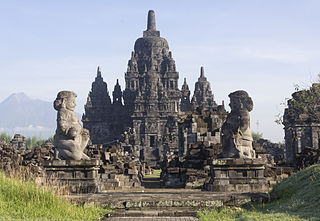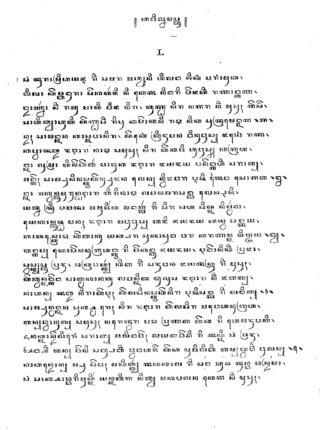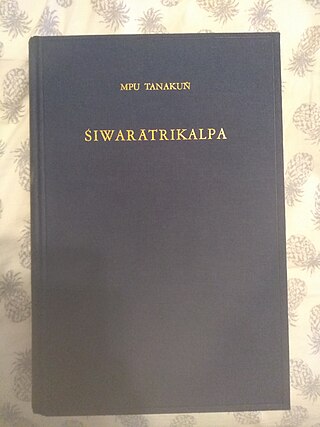Related Research Articles
Old Javanese or Kawi is the oldest attested phase of the Javanese language. It was spoken in the eastern part of what is now Central Java and the whole of East Java, Indonesia. As a literary language, Kawi was used across Java and on the islands of Madura, Bali, and Lombok. It had a sizable vocabulary of Sanskrit loanwords but had not yet developed the formal krama language register, to be used with one's social superiors that is characteristic of modern Javanese.

Bhinneka Tunggal Ika is the official national motto of Indonesia, inscribed in the National emblem of Indonesia, the Garuda Pancasila, written on the scroll gripped by the Garuda's claws. The phrase comes from the Old Javanese, translated to as "Unity in Diversity." The phrase is also mentioned in the Constitution of Indonesia, specifically in article 36A. The motto refers to the unity and integrity of Indonesia, a nation consisting of various cultures, regional languages, races, ethnicities, religions, and beliefs.

Hayam Vuruk (1334–1389), also called Rajasanagara, Pa-ta-na-pa-na-wu, or Bhatara Prabhu after 1350, was a Javanese Hindu emperor from the Rajasa dynasty and the 4th emperor of the Majapahit Empire. Together with his prime minister Gajah Mada, he reigned the empire at the time of its greatest power. During his reign, the Hindu epics, the Ramayana and the Mahabharata, became ingrained in the culture and worldview of the Javanese through the wayang kulit. He was preceded by Tribhuwana Wijayatunggadewi, and succeeded by his son-in-law Wikramawardhana.

A Buddhist temple or Buddhist monastery is the place of worship for Buddhists, the followers of Buddhism. They include the structures called vihara, chaitya, stupa, wat and pagoda in different regions and languages. Temples in Buddhism represent the pure land or pure environment of a Buddha. Traditional Buddhist temples are designed to inspire inner and outer peace.

Kakawin Ramayana is an Old Javanese poem rendering of the Sanskrit Ramayana in kakawin meter.

Kediri Kingdom was a Hindu-Buddhist Javanese kingdom based in East Java from 1042 until 1222. This kingdom is centered in the ancient city Dahanapura, despite the lack of archaeological remains, the age of Kediri saw much development in classical literature. Mpu Sedah's Kakawin Bharatayuddha, Mpu Panuluh's Gatotkacasraya, and Mpu Dharmaja's Smaradhana blossomed in this era. The kingdom's capital is believed to have been established in the western part of the Brantas River valley, somewhere near modern Kediri city and surrounding Kediri Regency.

Kakawin Bhāratayuddha is an Old Javanese poetical rendering of some books (parva) of the Mahabharata by Mpu Sedah and his brother Mpu Panuluh in Indian meters. The commencement of this work was exactly 6 November 1157 by Sedah, and finished by Panuluh. The year of the composition is given in a chronogram sanga-kuda-śuddha-candramā which gives the year 1079 Saka. This is the equivalent of 1157 AD. Bhāratayuddha means "India's War" or "War of Bharat".

Buddhism has a long history in Indonesia, and is one of the six recognized religions in Indonesia, along with Islam, Christianity, Hinduism and Confucianism. According to 2022 estimates roughly 0.7% of the total citizens of Indonesia were Buddhists, and numbered around 2 million. Most Buddhists are concentrated in Jakarta, Riau, Riau Islands, Bangka Belitung, North Sumatra, and West Kalimantan. These totals, however, are probably inflated, as practitioners of Taoism and Chinese folk religion, which are not considered official religions of Indonesia, likely declared themselves as Buddhists on the most recent census. Today, the majority of Buddhists in Indonesia are Chinese and other East Asians, however small communities of native Buddhists also exist.

The Nagarakretagama or Nagarakṛtāgama, also known as Desawarnana or Deśavarṇana, is an Old Javanese eulogy to Hayam Wuruk, a Javanese king of the Majapahit Empire. It was written on lontar as a kakawin by Mpu Prapanca in 1365. The Nagarakretagama contains detailed descriptions of the Majapahit Empire during its greatest extent. The poem affirms the importance of Hindu–Buddhism in the Majapahit empire by describing temples and palaces and several ceremonial observances.

The Sanjaya dynasty was a Javanese dynasty which ruled the Mataram Kingdom in Java during the first millennium CE. The dynasty promoted Hinduism on the island.
Kakawin are long narrative poems composed in Old Javanese, also called "Kawi", written in verse form with rhythms and meters derived from Sanskrit literature. Poets used a formalized literary language, rather than the vernacular. Poets composed and performed the poems at the courts of central and east Java kings between the 9th and 16th centuries, and in Bali.

The Lawu, or Mount Lawu is a massive compound stratovolcano straddling the border between Ngawi, East Java and Central Java, Indonesia. The north side is deeply eroded and the eastern side contains parasitic crater lakes and parasitic cones. A fumarolic area is located on the south flank at 2,550 m. The only reported activity of Lawu took place in 1885 when rumblings and light volcanic ash falls were reported. The recent study provided insights into geothermal heat flow suggesting that Mt. Lawu is still active today.
Merle Calvin Ricklefs was an American-born Australian scholar of the history and current affairs of Indonesia.

Kakawin Sutasoma is an Old Javanese poem in poetic meters. It is the source of the motto of Indonesia, Bhinneka Tunggal Ika, which is usually translated as Unity in Diversity, although it means '(Although) in pieces, yet One'. It is not without reason that the motto was taken from this kakawin as the kakawin teaches religious tolerance, specifically between the Hindu and Buddhist religions.
Javanese literature is, generally speaking, literature from Java and, more specifically, from areas where Javanese is spoken. However, similar with other literary traditions, Javanese language works were and not necessarily produced only in Java, but also in Sunda, Madura, Bali, Lombok, Southern Sumatra and Suriname. This article only deals with Javanese written literature and not with oral literature and Javanese theatre such as wayang.

Bernard Arps, Professor of Indonesian and Javanese Language and Culture at Leiden University, Netherlands, was born in 1961 in Leiden.

Śiwarātrikalpa, also known as the Kakawin Lubdhaka is an Old Javanese Hindu kakawin text written by Mpu Tanakung. This text aimed to spread the observance of Maha Shivaratri from the Vijayanagara Empire, who had given a great impetus to the revival of Saivite Hinduism, to the Hindus of Indonesia. It is believed to have been composed about 600 years ago, between 1466 and 1478, at a point when the Saivism sect of Hinduism dominated Java. Scholars have theorized that this revivalist zeal in Java was the result of the emerging Malacca Sultanate, through which Islam had been making gains in Java, and Indonesia in general.

Buda Script or (Aksara Buda) or Gunung Script is an archaic script. Based on its shape, the Buda Script still has a close relationship with the Kawi script. This script was previously used on the island of Java and Bali. This type of script is called the Buda script because it is considered to have originated from the pre-Islamic era which is called the Buddhist Age. The word Buda is based on the Buddha word. Manuscripts containing writing using the Buda script are commonly found in mountainous areas. Because of that, this type of script is also called the "Mountain script".

Mpu Tantular was a famous Javanese poet of Javanese literature who lived in the 14th century, during the reign of king Hayam Wuruk. Tantular was a Buddhist, and was respectful to other religions. This can be seen in two items of kakawin or poetry, the Kakawin Arjunawijaya and Kakawin Sutasoma. One of the verses from the Kakawin Sutasoma was later taken as the motto or motto of the Republic of Indonesia: "Bhinneka Tunggal Ika" or different but one.
Mpu Dusun was a Javanese Buddhist guru and writer who lived in the later Majapahit period, in the late 14th to early 15th century period.
References
- ↑ Supomo (1977:1-5)
- ↑ Tantular, Mpu; Molen, W. van der (Willem), 1952-; Arps, Bernard; Rijksuniversiteit te Leiden. Bibliotheek. Manuscript. (Cod. Or. 2048.) (1994), Serat lokapali kawi : an eighteenth-century manuscript of the Old Javanese Arjunawijaya by Mpu Tantular : a facsimile edition of manuscript Cod. Or. 2048 in the Library of Leiden University, Indonesian Linguistics Development Project in co-operation with Legatum Warnerianum in the Library of Leiden University, ISBN 978-90-73006-04-1
{{citation}}: CS1 maint: multiple names: authors list (link) CS1 maint: numeric names: authors list (link) - ↑ Aoyama, Toru (1992), A study of the Sutasoma kakawin : a Buddhist narrative in the fourteenth century Java , retrieved 2 March 2024
- ↑ Tantular, Mpu; Santoso, Suwito, 1927-; International Academy of Indian Culture (1975), Sutasoma : a study in Javanese Wajrayana, International Academy of Indian Culture, retrieved 2 March 2024
{{citation}}: CS1 maint: multiple names: authors list (link) CS1 maint: numeric names: authors list (link) - ↑ Poerbatjaraka (1952:41)